appliances
Thursday, December 2nd, 2021
Sales and Service counters
Just in time for the holidays when people are shopping, this newsletter will explain what is required for people with disabilities to be able to shop and make purchases at retail stores.
The ADA Standards in section 904.4 states where provided, at least one of each type of sales counter and service counter shall comply and be accessible. Below you will see the technical requirements.
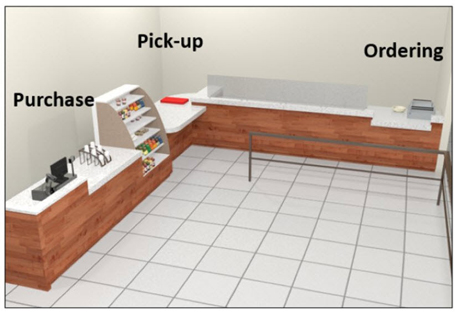
The picture above shows an “L” shape counter that has many services. Therefore each type of service will require an accessible counter.. These counters have parallel approaches.
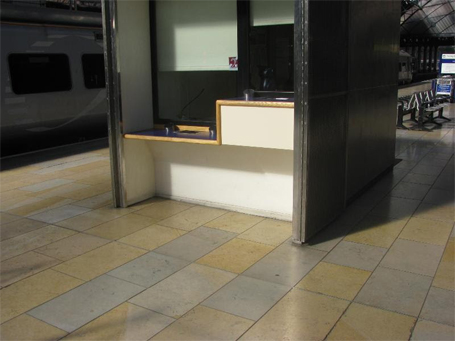
The picture above is an information counter which is considered a “service” counter. This counter has a forward approach which is not required, but allowed. One thing to keep in mind is that no “transaction” is required for it to be considered a service counter.
Section 904.4.1 gives us the requirements that a sales or service counter must be 36” high maximum above the finished floor (it can be lower). The counter must be an integral part of the main counter. It cannot be folding, or flipping or tacked on the side of the counter.


The accessible portion of the counter must be the same depth as the main (or public) side of the counter.
Even though the reception counter shown below is deeper than the public counter that is higher, the accessible portion will only have to be the same depth as the counter that is taller since that is the “public’ sales counter.

An accessible sales and service counter must be 36″ long minimum (it could be longer). Remember that the standards when they state a minimum, you are allowed to make it longer.
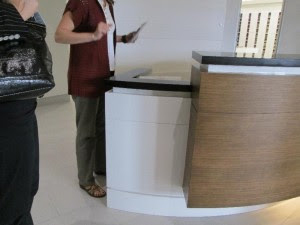
This counter is at the right height, but it is shorter than 36″

A reception that is a piece of furniture, not built in or fixed, will not have to comply with the standards, although we recommend that you provide accommodations if possible.

This accessible portion is an integral part, but a portion projects more than 4″ onto a circulation path. This was probably intended to have a forward approach knee and toe clearance (which is not required, but allowed). The counter must have cane detection on either side in order that it does not create a protruding object.
At an accessible portion of the sales and service counters, a parallel approach or a forward approach with a knee and toe clearance are allowed (depending on the preference). Either one is acceptable, but if you decide to create a forward approach, then a knee and toe clearance that complies with section 306 must be provided.

The service counter shown above has forward approach with a knee clearance
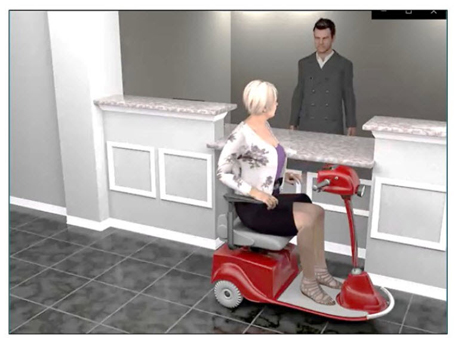
The service counter shown above has parallel approach.
Monday, November 1st, 2021
Are there any allowable tolerances in the ADA?
Construction is not a perfect science. No matter how accurate we try to draw or how careful one is to build and install materials, there will probably always be some error or omission that comes up. Best practices is to allow for the possibility of mistakes by incorporating ranges into our design. That is also what we find in the ADA and other accessibility guidelines.

How does the ADA deal with construction tolerances? First of all the tolerances ONLY apply to “construction”. There are no tolerances allowed in design. Therefore as architects and designers, we must design our spaces with enough room for construction errors. I recommend to my clients to not design to the maximums or minimums written in the Standards.
Most dimensions in the ADA Standards are specified as a minimum, maximum, or as a range. In a few areas, absolute dimensions are specified.
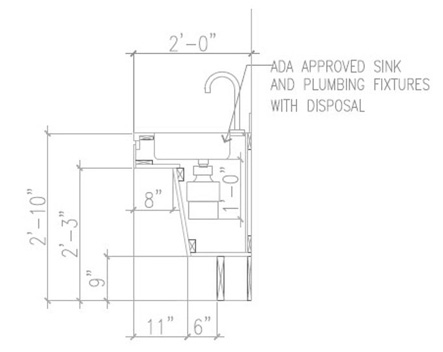
The detail shown above is showing the absolute maximums and minimum dimensions shown in the ADA Standards. There is no room for construction errors. My recommendation is to detail below the maximum and above the minimums so that you build some tolerances prior to construction.
Ranges
The 2010 ADA provides some requirements with a specified range. For example, the location of the toilet should be between 16”-18”. When a range is stated, it provides an adequate tolerance and therefore no tolerance outside of the range at either point is permitted.
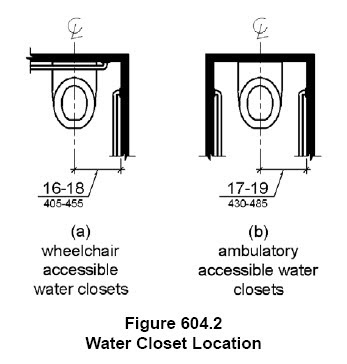
The ADA provides a range for the location of a water closet

This water closet is not compliant because it is located at 18 1/2″ from the side wall to the centerline of the toilet. Even though this water closet is located just 1/2″ beyond the allowable high range, because there was a low and high number as ranges, tolerances are not allowed. Tolerances are built in to the range.
Maximum and Minimums
When the ADA states a maximum or a minimum dimension that does not have two specific minimum and maximum end points, tolerances may apply. For example, a door pull side maneuvering clearance is stated to require 18″ min. If the door has a maneuvering clearance that exceeds the minimum allowable dimension instead, it might be allowed according to the amount of lee way given as the industry standard. According to the Access Board, only 3/32″ is allowed as tolerances for door maneuvering clearances.
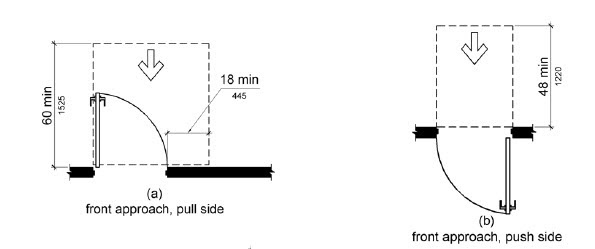
The ADA figures above show the minimum manevering clearances at the door


The door above has a maneuvering clearance of less than 18″. The clearance is 17″ clearance. Even though it is only 1″ less than what the minimum requires it does not comply with industry tolerances of 3/32″
According to the US Access Board and the Department of Justice, tolerance is an unintended, but permitted (i.e., “tolerated”), variation from a specified dimension resulting from the process of construction or manufacture. The ADA Standards recognize conventional industry tolerances for dimensions not expressed as a range. This applies to field work, not design work. Tolerances necessary for a particular manufacturing process are also permitted. Information on specific tolerances may be available from industry and trade organizations, code groups and building officials, and published references.
The position of the U. S. Access Board – as formalized in the ADA/ABA Guidelines in Section 104.1.1 – is that industry standard tolerances should be relied on when questions regarding this issue arise. However, not many trades have codified specific tolerances for many of the elements mentioned in ADA/ABA Guidelines, nor have they developed accepted industry protocols for measuring when questions of accessibility arise. Our colleagues at Corada has completed research on where to find industry standard tolerances. Here is the link
Absolute dimensions
Some dimensions in the ADA are a complete absolute. For example in a transfer shower you are only allowed a 36″x36″ size . There is no maximum or minimums allowed and there is not a range. Therefore industry standard tolerances are allowed. Some manufacturers will make the walls 36″x36″ but the base is narrower.
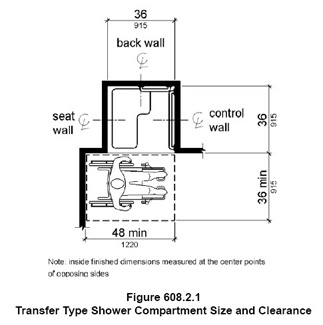

The shower above was built larger than 36″x36″

The depth of the shower was 39″
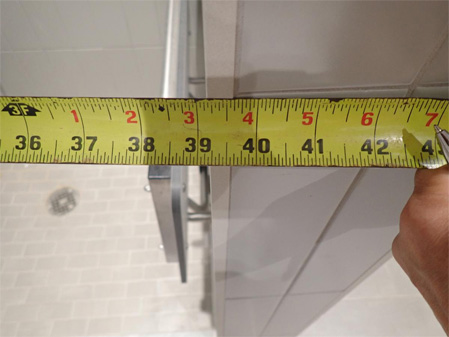
The width of the shower was 39″
Sometimes I get asked why is the transfer shower need to be exactly 36″ x36″? Below is the image of the Access Board’s reply. The shower is designed and built so that a person with disabilities can easily and safely transfer onto the shower seat and be able to reach not only the controls but the grab bars as well without much difficulty and without losing balance.

In our research we found that if the shower is constructed of gypsum board, there is a 1/8” tolerance allowed by the industry. This was found in David Kent Ballast, AIA CSI’ Handbook of Construction Tolerance page 198.
Summary
Remember that as you design, allow for construction mistakes (because we all know they happen). There are no tolerances allowances for design mistakes.
If the ADA gives you a range, don’t design to the highest or the lowest number. Always pick a number in the middle.
If the ADA gives you a number not to exceed, then there might be some tolerances, but again do not design to the maximum or minimum number they give you. Always allow for some built in tolerances.
If the ADA gives you an absolute number, then the industry standard tolerances will be able to be used if that number is not achieved. These vary but some references below have codified it.
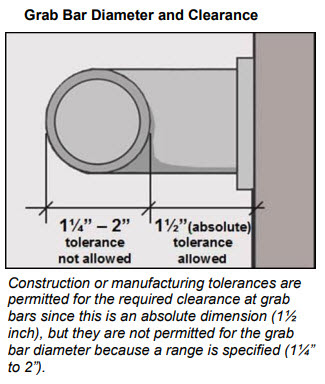
References
National Engineering Handbook
David Kent Ballast, AIA CSI’ Handbook of Construction Tolerance
Friday, October 1st, 2021
What doors are required to comply with ADA?
There seems to be a confusion about which doors are required to comply with the Americans with Disabilities Act. Most people understand that doors that lead you to accessible public spaces and rooms have to comply. But many don’t realize that ALL doors that allows “user passage” must comply with the standards. There is just one exception: a door that allows user passage but it is leading into a room that is exempted from accessibiltiy (i.e. a machinery space).
Knowing that information, let’s delve into what doors are required to comply and what are the requirements.
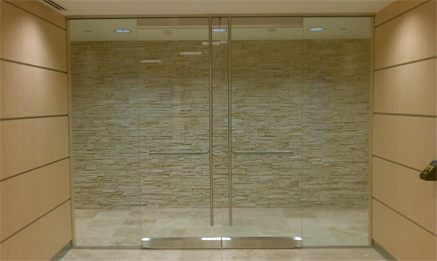
Doors that allow user passage like the one shown above must comply.
Which Doors must comply?
In section 206.4 of the ADA it gives us the requirements for which type of doors must be accessible.
206.4 Entrances. Entrances shall be provided in accordance with 206.4. Entrance doors, doorways and gates shall comply with 404 and shall be on an accessible route complying with 402
206.5 Doors, Doorways, and Gates. Doors, doorways, and gates providing user passage shall be provided in accordance with 206.5.206.5.1
This paragraphs lets us know that only entrance doors are going to have requirements. Exit doors are not fully exempted. The door to “exit” a space is technically an “entrance” to the exit. Therefore the side of the door which allows user passage must also comply.

Even though this is a means of egress door and has limited requirements in the ADA Standards, it is considered a door that allows user passage and must comply.
206.5 continues to tell us which spaces must have doors that comply:
- Each entrance to a building or facility (there are some restrictions, so be sure to understand them)
- Within a building at least one door serving each room (even work areas)
- In transient lodging facilities all entrances providing user passage into and within guest rooms that ARE NOT required to provide mobility features (but only the clear width)

This floor plan shows a hotel room that is not required to have mobility features. All doors (except the shower door) which allows “user passage” into and within the room must comply. A 32″ clear width should be provided. All other requirements are not mandated.
A common misunderstanding is the term “user passage”. A user that they are describing is not only people who use wheelchairs, but also ambulatory and able bodied users. Therefore even if the room where the door is located is not large enought for a wheelchair, the door clear width into the room must still comply. Note the water closet room. That door must also comply with providing at least a 32″ clear width, even if the room is not large enough for a wheelchair to enter.

This storage closet appears to be the type that allows user passage, and therefore the door must comply with the techical requirements.
What are the technical requirements?
To find the technical requirements we look in section 404 which explains how to make the required doors accessible.
Doors, doorways and gates must meet the following standards:
- Must have a clear width of 32″
- Must have proper maneuvering clearances to allow for a person to open the door and go through
- The floor and ground surface at the maneuvering clearance must be stable, firm, slip resistant and must have a slope no steeper than 1:48
- A threshold that is not higher than 1/2″ must be provided
- The hardware must be the type that does not require tight grasping and twisting of the wrist, plus must be mounted between 34″-48″ a.f.f.
- The door should not close too fast (no faster than 5 seconds)
- The opening force should not be too heavy (no more than 5 lbs on an interior door)
- The bottom surface at the push side should be smooth
- If it has a vision light it should be mounted no higher than 43″ a.f.f. (a peep hole is not a vision light)
- And if there is an automatic door, there are some additional requirements (under 404.3)

This door had a clear width of 28 1/2″. The minimum requirement is 32″ clear

This picture shows the proper maneuvering clearance to reach the door handle and to go through the door
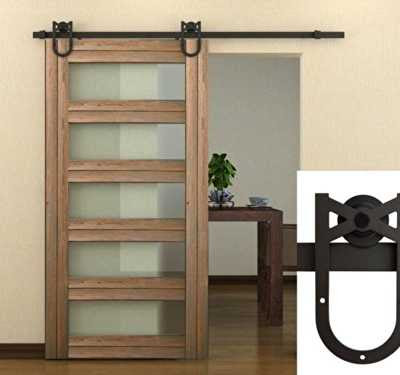
Even sliding doors are required to have maneuvering clearance. The only ones that will not is for shallow closets that do not provide user passage

This video shows you the requirements for door maneuvering clearances
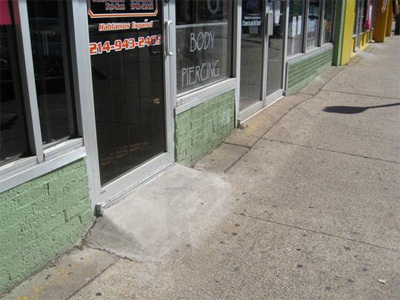
The door shown above has a slope steeper than 1:48 at the maneuvering clearance, and a threshold higher than 1/2″

The door shown above has hardware that requires tight grasping and twisting of the wrist to operate
A dining counter has a forward approach knee clearance and it is 34″ a.f.f.


The door hardware in this door was mounted at 61″ a.f.f. (higher than the allowed 48″ a.f.f.)
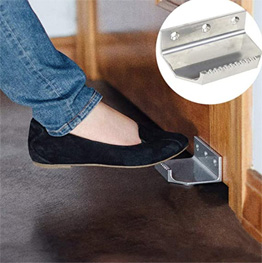
Because the push side of the door must have a smooth surface, a foot opener cannot be used on the push side
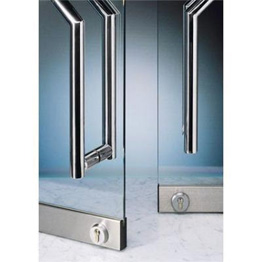
In addition, the door hardware on the push side of the door must not be lower than 10″ a.f.f.

The vision light shown above was mounted higher than 43″ a.f.f. to the glazing.
Wednesday, September 1st, 2021
Section 810.2 Bus Loading Zones
This newsletter will speak about Bus Loading Zones both in the Public Right of Way and inside a property (like a school or other facility).

The bus stop in the above picture does not show the proper requirements for loading and unloading. This newsletter will explain why

The bus stop in the above picture is at a school and appears to have the correct area for loading children with disabilities
Technical Requirements
Bus loading zones must have an area that 96″ long measured perpendicular to the curb or vehicle roadway edge, and a clear width of 60 inches (1525 mm) minimum, measured parallel to the vehicle roadway.

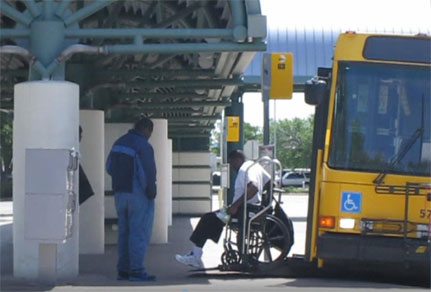
The video above shows why the 96″ long area parallel to the curb is required. The lift mechanism for a wheelchair user to enter and exit the bus requires that amount of space.
If there is a bus shelter there should be a path of travel from the bus shelter to the loading area. The path needs to be a minimum of 36″ wide. There should be an area inside the shelter that is 30″x48″ with a slope of no greater than 1:48

Parallel to the roadway, the slope of the bus stop boarding and aligning area shall be
the same as the roadway, to the maximum extent practicable. Perpendicular to the roadway, the slope of the bus stop boarding and alighting area shall not be steeper than1:48.
It is important to note the last requirement: The slope at a bus loading zone that is parallel with the road can be the same as the roadway and is not required to be 1:48

This bus loading zone does not have a 96″ long space parallel with the curb
Monday, August 2nd, 2021

Accessible Work Areas
Thank you to Marsha Godeaux from TDLR for taking the time to explain about employee work areas. Click here to watch the video.
This newsletter will cover Employee work areas. There is a misunderstanding that work areas are not required to comply with the ADA or TAS Standards. We will explain what is required to comply within work areas and what is exempted. Keep in mind that the requirements we are covering are only the 2010 ADA Standards and the 2012 Texas Accessibility Standards. The ABA which covers Federal Facilities do not have the same requirements.
What is a Work Area?
Employee Work Area. All or any portion of a space used only by employees and used only for work. Corridors, toilet rooms, kitchenettes and break rooms are not employee work areas.
Work Area Equipment. Any machine, instrument, engine, motor, pump, conveyor, or other apparatus used to perform work. As used in this document, this term shall apply only to equipment that is permanently installed or built-in in employee work areas. Work area equipment does not include passenger elevators and other accessible means of vertical transportation.

Work cubicles are part of a work area
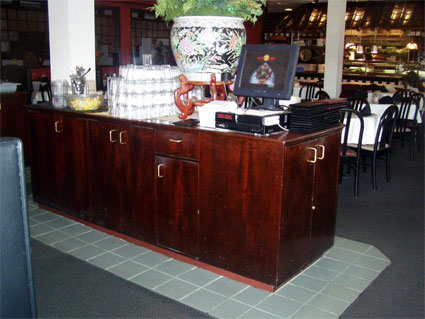
a Point of Sale counter is considerd a work area as long as the public is not required to approach it.
What are the requirements?
203.9 Employee Work Areas. Spaces and elements within employee work areas shall be designed and constructed so that individuals with disabilities can approach, enter, and exit the employee work area.
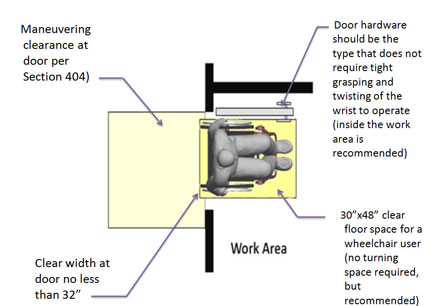
The image above summarizes the approach, enter and exist requriement
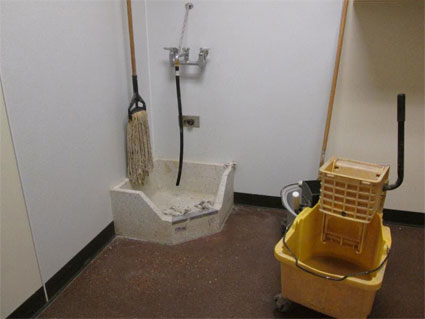
An example of a work area that only requires an approach, enter and exit would be a janitor’s closet. Elements within the janitor’s closet such as the faucet for the mop sink will not be required to comply.
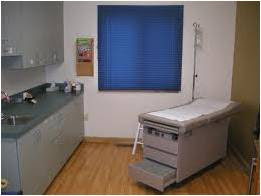
An exam room is partially a “work” area and partially a “patient” area. The area that is only used by the doctor (the sink) will be exempted from having to comply.
What are some exceptions?
Employee work areas, or portions of employee work areas, other than raised courtroom stations, that are less than 300 square feet and elevated 7 inches or more above the finish floor or ground where the elevation is essential to the function of the space shall not be required to comply with these requirements or to be on an accessible route.
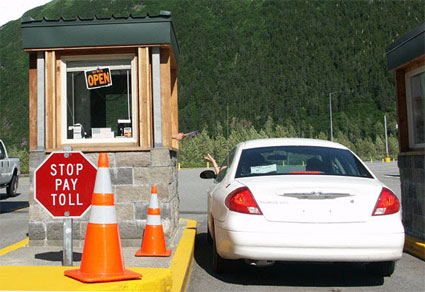
This toll booth is less than 300 s.f. and elevated more than 7″ a.f.f. and therefore do not require an accessible route to it or the ability to approach it and enter it.
Common Circulation Path
In addition to approach, enter and exit, if the employee work area is larger than 1,000 s.f.. then a common path within the work area to common use spaces shall be provided
206.2.8 Employee Work Areas. Common use circulation paths within employee work areas shall comply with 402.

A “common” circulation path is one that is used by more than one person and not intendend for work
Section 402 states that a minimum 36″ width shall be provided along the circulation path.
EXCEPTIONS:
1. Common use circulation paths located within employee work areas that are less than 1000 square feet (93 m2) and defined by permanently installed partitions, counters, casework, or furnishings shall not be required to comply with 402.2.

This raised work area is allowed since the work area is less than 1,000 s.f.
If the path is around work area equipment, then it will not have to comply with the 36″ clear width.
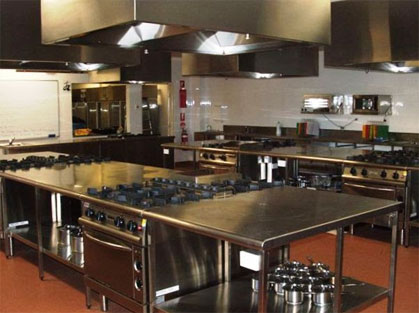
This commercial kitchen has equipment that is an integral part of the work area. The 36″ min. circulation path in this space is not required to comply due to the location of the work area equipment.
Protruding Objects
Even though the only requirement for a work area is “approach, enter and exit”, it also requires that circulation path be provided. Part of the circulation path has to make sure there are no protruding objects projecting onto the circulation path more than 4″. This requirement are for any employee or visitor to the employee area that might be visually impaired.
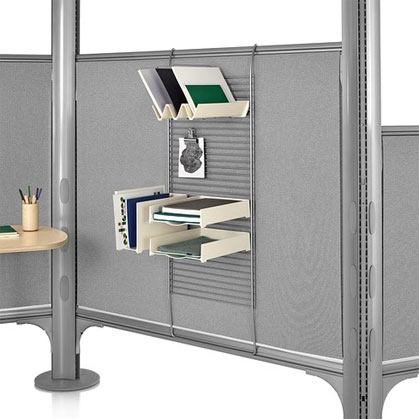
the filing system is located along the common circulation path inside the office space and projects more than 4″ onto the circulation path.
What about other employee areas that are not work related?
The requirements thus far have been for areas that are considered part of the “work” areas in a space. But there are other areas that are also part of an employee area, but are not related to the work they perform. Those areas that are NOT related to their job description will not be exempted and must comply. Below are a few examples of areas that might be for employees only, but must be fully compliant with the Standards:
Break Rooms
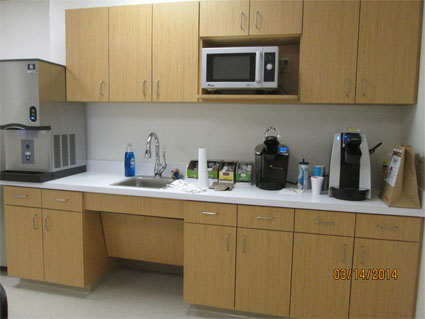
even though a break room is not a public area, it is still required to comply with the ADA and TAS because it is not considered a “work” area, but rather a space where they take a break from work.
LEED employee shower and employee restrooms

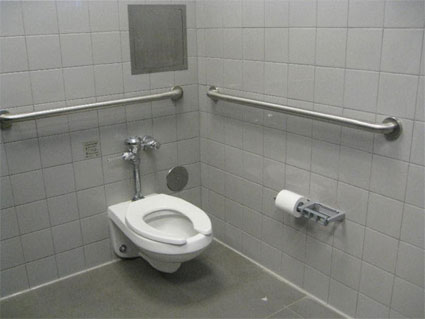
an employee shower or even an employee restroom are also not considered “work” areas and must comply.
Employee Locker Room
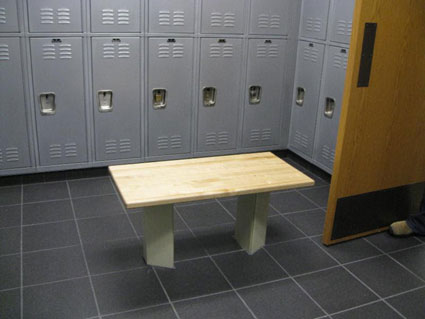
The lockers as well as the bench in this locker/dressing room must comply with the Standards
What happens when an employee is disabled?
The Standards sometimes provide additional guidance through “advisories”. These are NOT requirements, but they are suggestions that might make your design a better one. Below are some of the advisories on work areas:
Advisory 203.9 Employee Work Areas. Although areas used exclusively by employees for work are not required to be fully accessible, consider designing such areas to include non-required turning spaces, and provide accessible elements whenever possible.
Under the Title I of the ADA, employees with disabilities are entitled to reasonable accommodations in the workplace; accommodations can include alterations to spaces within the facility. Designing employee work areas to be more accessible at the outset will avoid more costly retrofits when current employees become temporarily or permanently disabled, or when new employees with disabilities are hired.

Thursday, July 1st, 2021
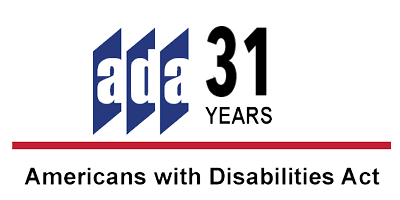
Abadi Accessibility is proud to support the Americans with Disabilities Act (ADA) 31st Anniversary. On July 26th we celebrate this important civil rights law that works to ensure all people with disabilities have the same rights and opportunities as everyone else. Celebrate with us by visiting: www.adaanniversary.org/ #ADA31 #ThanksToTheADA
How are you planning to celebrate Americans with Disabilities Act (ADA) 31st Anniversary? This July 26th the ADA National Network and individuals, communities, and organizations across the country will be participating. Learn how you can be involved by visiting www.adaanniversary.org/ #ADA31 #ThanksToTheADA
Introduction to our newsletter:

After I wrote my first newsletter about counters, my clients are still not clear on all the different requirements for the different types of counters and fixed or built-in surfaces that the ADA requires to be accessible. First of all let me review that there are five type of counters scoped in the ADA Standards: Work surfaces, dining counters, service counters, sales counters and check out counters. Then there are two type of counters that are not scoped: work area counters and non-work area common use counters that do not fall under the other listed. There are also Food service lines, as well as other portions public side service areas. For those please check out my newsletter I wrote I 2014.
This newsletter will explain the different requirements for dining surfaces, non-employee work surfaces and sales and service counters.
Dining Counters
According to Scoping section 226, at least 5% of seating spaces and standing spaces at dining surfaces must comply with 902. Standing spaces are those counters where people might stand to eat or drink rather than sit. Those counters must also comply. Some examples of dining counters are bars where drinks are served, fast food establishments with fixed tables, and booths and banquettes at a restaurant.
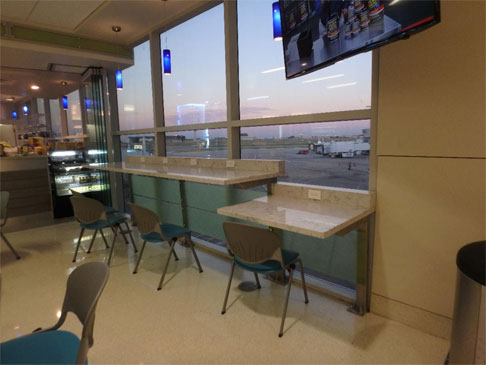
These fixed dining counters in a cafeteria is an example of a dining surface.

a bar is an example of a dining surface
Section 902 gives us direction on how to make the dining surfaces accessible:
- There must be a knee clearance complying with section 306 so that a person in a wheelchair will approach and use the counter in a forward approach
- The height of the counter must be between 28″-34″ a.f.f. PLEASE NOTE….WE RECOMMEND TO NEVER USE THE MINIMUMS OR MAXIMUMS WHEN DESIGNING.
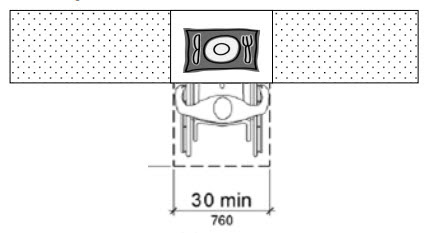
A dining counter should have a 30″ width and a 17″ min. depth at the knee clearance.
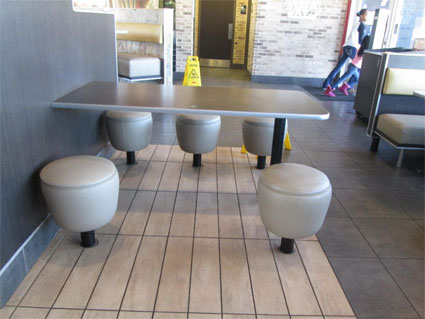
A dining counter has a forward approach knee clearance and it is 34″ a.f.f.
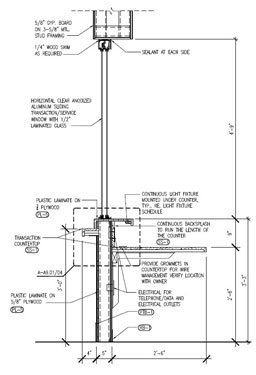
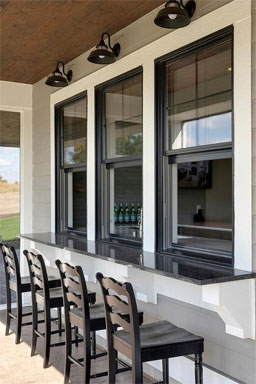
This is a dining counter but also a service window. It is acceptable to have the dining counter in front of the service counter
Non-Employee Work Surfaces
Section 226 tells you that 5% of non-employee work surfaces must comply and meet the requirements set forth in section 902. These are also required to be dispersed throughout the space they are in. Section 902 states that a work surface must have a forward approach with a knee space per section 306 and be 30″ wide minimum and 34″ high maximum
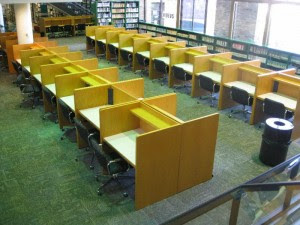
Study carrols in a library is an example of a non-employee work surface
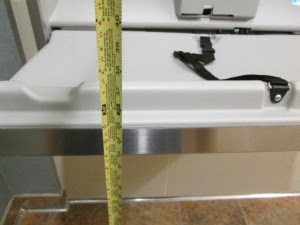
Diaper changing counters are also considered a “work surface”

A patient registration desk is another example of a non-employee work surface
All the requirements in section 902 are for non-employee work surfaces (or for the public). Employee work surfaces that are part of a work area are exempted until such time when a person with disabilities is hired at which point, the surface must be provided to accommodate them and their abilities.
Sales and Service counters
Where provided, at least one of each type of sales counter and service counter shall comply with 904.4.
Where counters are dispersed throughout the building or facility, counters complying with 904.4 also shall be dispersed.
Keep in mind that the requirements are the either sales or service counters. The term “transaction” is no longer used. A transaction could occur but it is not the only pre-requisite for compliance.
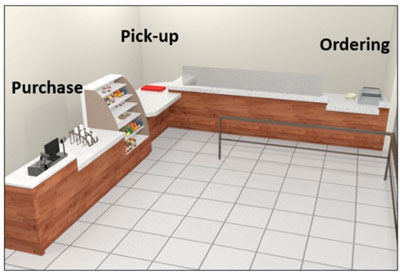
The counter shown above has different functions (some are sales and some are service). Each one must have a portion at an accessible height
Section 904 gives us the following requirements for sales and service counters:
- 36” high maximum
- Same depth as the main counter
- 36” length min.
- Parallel approach OR Forward approach allowed
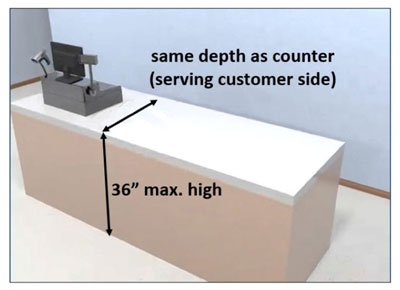
the accessible couter must be 36″ a.f.f. maximum and at least 36″ long

A sales or service counter can have either with a forward approach knee clearance or a parallel or side approach.

The accessible portion of the counter must be the same depth as the main (or public) side of the counter. Even though the reception counter is deeper than the public counter, the accessible portion will only have to be 36″ a.f.f. maximun and 36″ min. long the same depth as the public counter (which can be higher than 36″ a.f.f.)
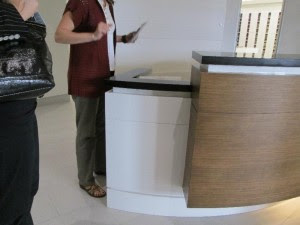
The reception desk is considered a “service” counter because information is a service a business would provide to their guests. The one shown above did not have a 36″ long counter
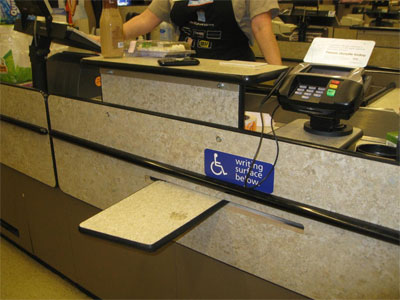
A service or sales counter may not be the type that is flipped up, or pushed in once it is used. it must be a permanent counter that is always available.
Tuesday, June 1st, 2021
Inspector’s Corner
Today’s newsletter I bring you some examples of violations that I found during my on site inspections. These specific ones are violations that were made because the standards were not so well understood. Hopefully these examples will give you some clarity for future installations.
Clearance at the drinking fountains
The drinking fountains that are mounted along a circulation path might be a protruding object if the leading edge is higher than 27″ a.f.f. When the leading edge is higher than 27″ a.f.f. which most of the time it will be the drinking fountains for standing persons, then that drinking fountain will be considered a protruding object. To resolve the violation, we typically see a cane detectable apron installed at the bottom edge of the high drinking fountain. Since the high drinking fountain is not for people in wheelchairs, but for people who are standing but have trouble bending down to drink, a knee clearance is not required. So technically the cane detectable apron could be mounted at any height as long as it reaches a minimum of 27″ a.f.f.
The misunderstanding is of the requirement that the clear floor space of the wheelchair be located centered with the low unit for them to use
602.2 Clear Floor Space. Units shall have a clear floor or ground space complying with 305 positioned for a forward approach and centered on the unit. Knee and toe clearance complying with 306 shall be provided.
So that means that the 30″ clear floor space will be partially located under the high drinking fountain

If the cane detectable apron located at the high drinking fountain is lower than 27″ a.f.f., it will reduce the required knee clearance at the low drinking fountain
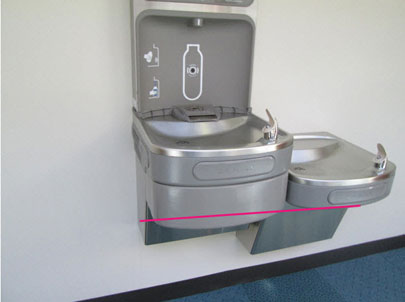
The cane detactable apron is lower than 27″ a.f.f. which reduces the knee clearance which is centered at the low drinking fountain
In order to not have that violation, the cane detectable apron must be mounted exactly at 27″ a.f.f.
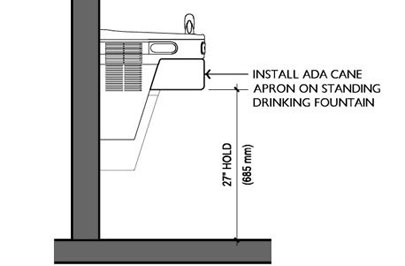
Post-mounted protruding objects
(this is not exactly examples of violations, but rather why it is not a violation)
The rules for protruding objects allows post or pylon mounted obects to project 12″ from its mounting surface. The figure below is from the ADA and TAS section 307.3 which shows the parameters of the protrusion limits.
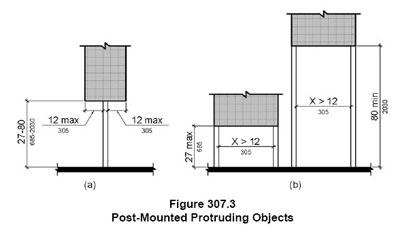
My example is from an interior play area where there was a statue of one of their characters mounted on a pylon or tall base. The statue had a little hand and pigtail that projected beyond the edge of the base. But because the ADA and TAS allows a 12″ protrusion limit along the circulation path, the statue was not a protruding object.
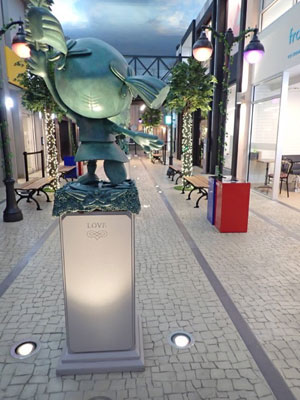

The little hand of the statue projected 6″ beyond the base, which was compliant.
Another example of a post mounted protruding object is a stand pipe located at a means of egress stair landing. Because the means of egress is essentially a circulation path it will require that the protrusion limits that the ADA and TAS describe in section 307 be adhered to.
The stand pipe in the photo below does have an extension where the valve is projecting more 12″ beyond the pipe and mounted higher than 27″ a.f.f.

The stand pipe is a protruding object because the valve projects more than 12″ from the post onto the circulation path
Pendant lights as protruding objects
Sometimes the protruding objects occurs because the object is mounted below 80″ a.f.f. Pendant lights can be protruding objects if mounted too low. The condition shown in the photos below shows a play room with furniture mounted below the pendant lights. The pendant lights are mounted at 70″ a.f.f. and therefore are protruding objects.
But you might be asking why is it a violation since the furniture acts as our cane detection?
Good question…
What is a misunderstanding is that the only cane detection that is allowed must be fixed or buil-in (see the requirement below)
201.1 Scope. These standards apply to fixed or built-in elements of buildings, structures, site improvements, and pedestrian routes or vehicular ways located on a site.
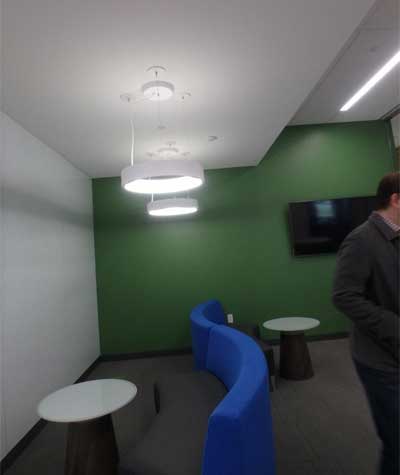
because the furniture below the pendant lights are movable and not built in they cannot be use as cane detection
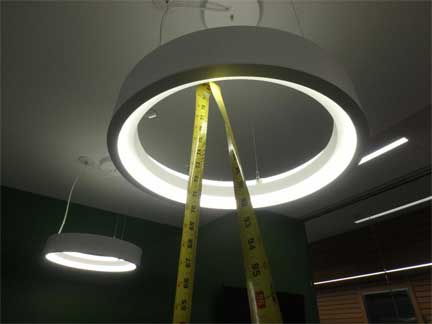
the pendant light is mounted at 70″ a.f.f. and is considered a protruding object
Monday, May 3rd, 2021
The 2010 ADA Standards for Accessible Design (The ADA for short) is sometimes used as a catch-all term for all requirements for designing for persons with dissabilities. What is sometimes misunderstood is that the ADA is a Civil Rights law with design guidelines for public accommodations and commercial facilities. But there are other laws and standards that govern how to design for persons with disabilities that are different from the ADA and still have to be followed. One of the standards are found in the building code. If a municipality has adopted Chapter 11 of the IBC that chapter references another Standards call the ANSI A117.1. The ADA and ANSI are very similar, but there are some differences. In this newsletter I will give you a few examples.
For the sake of this newsletter I wilil be discussing the 2017 ANSI A117.1 Standards. This may or may not be the Standared that has been adopted by the municipality you are designing under and you will need to verify which version you need to follow. Not all the versions have the same requirements.
304 Turning Space
Both the ADA and ANSI A117.1 have requirements for the size of a circular turning space. They used to be the same (60″ diameter), but In the 2017 version of the ANSI the size increased to 67″ min.
Below is the new figure for the 2017 ANSI
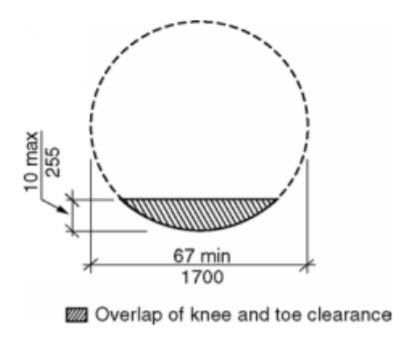
604.5.2 Rear Wall Grab Bar
Both in the ADA and the ANSI the section that discusses the rear wall grab bars is 604.5.2 But the location of the grab bar is measured differently in the ANSI than in the ADA. this confuses most installers and we typically find ADA violations based on the assumption that they are both the same.
Note the figure below. It is from the 2017 ANSI A117.1 604.5.2
It shows that the rear wall grab bar is located in relation to the side wall. It should measure 6″ from the side wall to the inner edge of the grab bar and it should have an overall dimension of 42″ min. from the side wall to the outer edge.

This is figure ANSI A117.1 604.5.2 from the 2017 version
Note the figure below. It is from the 2010 ADA section 604.5.2
It shows that the rear wall grab bar is located in relation to toilet. It should also be 36″ long min. just like the ANSI, but we locate it from the center of the toilet so that there is 12″ min. from the center to the inner edge and 24″ min. from the center to the outer edge.
The ADA rear wall grab bar location has no relation to the side wall.
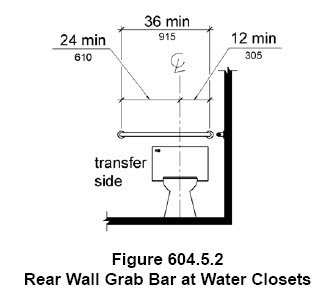
This is figure 604.5.2 from the 2010 ADA Standards. It shows the rear wall grab bar and its lcoation in relation to the toilet.
502 Parking
There are two sections that the ANSI has that the ADA does not: parallel parking and Electrical vehicle charging station parking.
502.9 Parallel Parking
The 2017 ANSI Standards has guidelines for parallel parking for on-street parking. It requires a vehicle space plus an access aisle parallel to the curb and a curb ramp or accessible route close to the spaces.
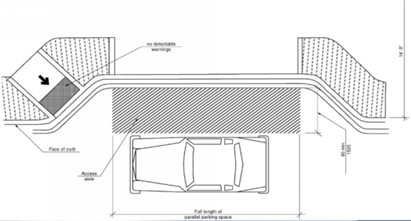
The figure 502.9.1 above shows on-street parallel parking
502.11 Electrical Vehicle Charging Stations
The 2017 ANSI Standards provide requirements for Electrical Vehicle charging stations. Some of them are
- Operable parts should be within reach
- There should be an access aisl adjacent to the parking space with clear floor sapce next to the unit
- Any protection bollards, curbs and wheel stops should not be located so it obstructs the route or the reaching.

Thursday, April 1st, 2021
It’s been a while since I have done an “Inspector’s Corner”….It was actually last April…must be an April Fools thing…but it is not. I go to many inspections and see some really interesting violations (amid all the common ones). I even learn from them. Here are three that I saw that are good to learn from:
Ambulatory Toilet compartments
There are two types of toilet compartments required by the ADA: one for wheelchairs and another for other mobility devices such as walkers, crutches, knee scooters etc. Those are called Ambulatory and the requirements are found in section 604.8.
Since they are for different types of disabilities they do have different configurations.


Some of the obvious things that are different is the width. The wheelchair toilet compartment is required to be 60″ min. wide while the ambulatory must be between 35″-37″. Also the location of the grab bars are different. But one of that was missed during my inspection was the length of the ambulatory.
If you see the size of the wheelchair toilet compartment you will notice that the depth can be between 56″ to 59″ depending on the type of toilet used.
The Ambulatory toilet compartment must be 60″ minimum.
So if you are designing the wheelchair toilet compartment to its minimum depth and the ambulatory is built the same, there will be a violation since the depths are slightly different
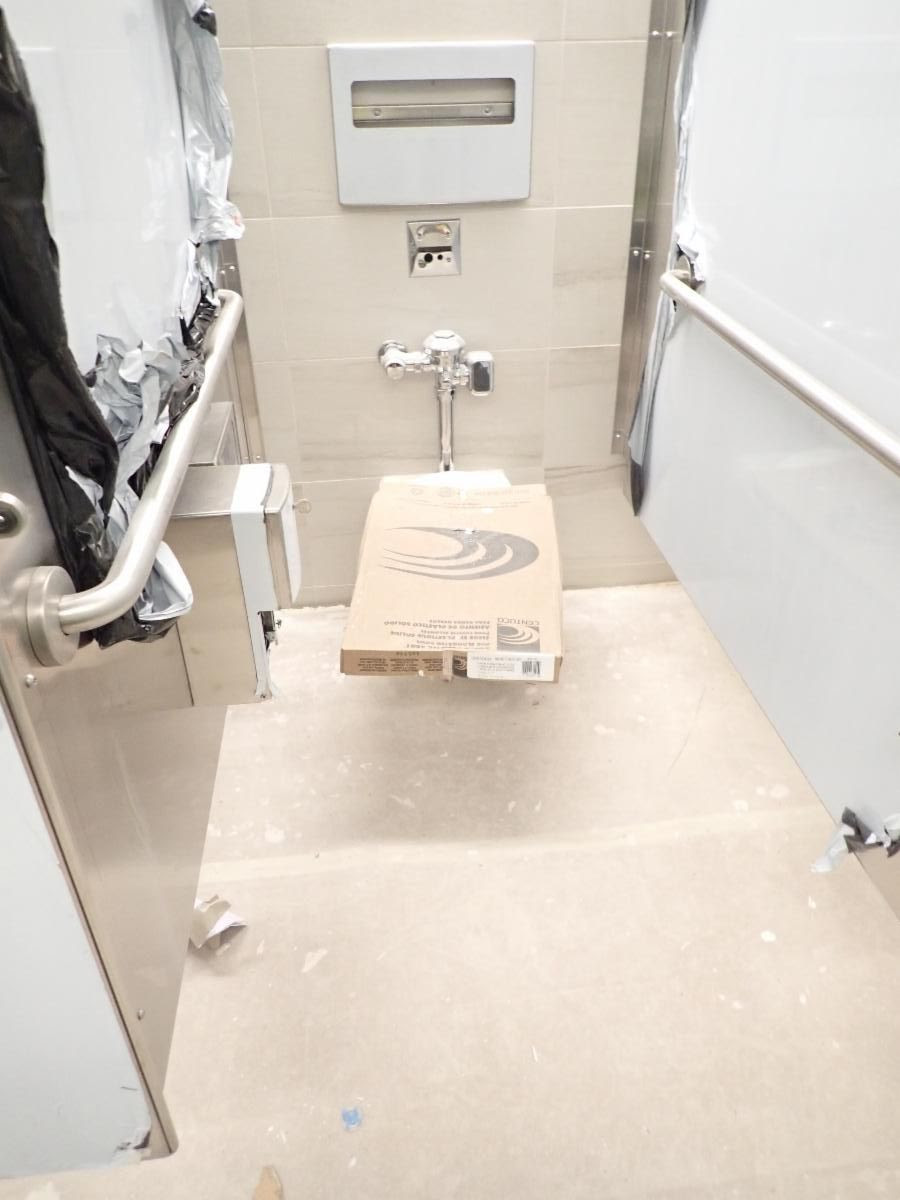
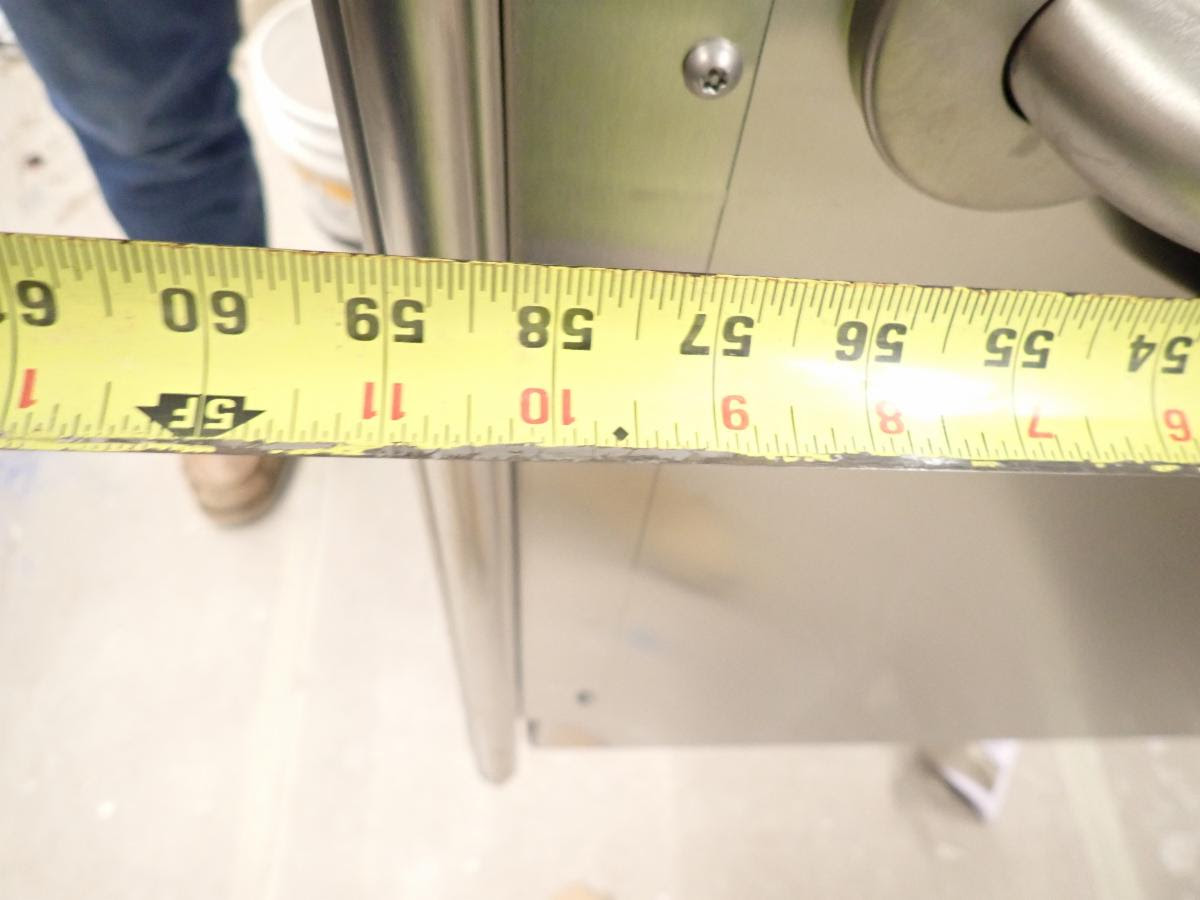
The ambulatory compartment was located next to the wheelchair compartment which was only 58″ long
Cane detectable aprons at Electric Water Closets
As we have learned, persons who are visually impaired will require feeling their way through the built environment rather than seeing. So if there are any objects along the path that they will use to circulate that might be mounted above 27″ a.f.f. (which is the height where they cannot detect the object with their cane), then the object should not be deeper than 4″ or it will be considered a “protruding object” and will violate the standards.
One object that is typically considered protruding objects are electric water cooler (EWC) or drinking fountains.
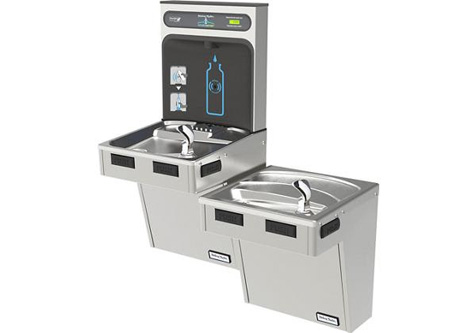
The drinking fountain shown above if mounted along a circulation path the high one will not be detectable and will be considered a protruding object
A good solution for drinking fountains that are protruding onto the circulation path is to create “cane detection” by using a cane detectable apron which most manufactures have as an accessory that can be added after market. The apron should be located under the “protruding object” which is typically the high drinking fountain. If mounted correctly it will reach the 27″ a.f.f. which provides cane detection and will resolve the violation.
The issue becomes when the use of the cane detectable apron is misunderstood. Some contractors do not understand why they are being installed and will mount them to the wrong drinking fountain.

The drinking fountain shown above has a cane detectable apron mounted under the wheelchair accessible drinking fountain. That drinking fountain was not the protruding object but in addition not the wheelchair drinking fountain does not have a knee clearance due to the apron.

the cane detectable apron was mounted under all the drinking fountains. In addition, the cane detectable apron was not required since the wing walls that were installed would have been used as cane detection as well.
Changes in Level
The ADA Standards has a chapter called “Changes in Level” which states that along the accessible route you may not have any changes in level greater than 1/4″ or 1/2″ with a bevel.

One of my inspections had a roll in shower inside a restroom. The turning space of the restroom was partially located inside the roll in shower. The roll in shower had a collapsable curb which reached 1/4″ of heigh once the wheelchair would rolll on it.

The drawing is showing the location of the turning space which overlaps inside the roll in shower.
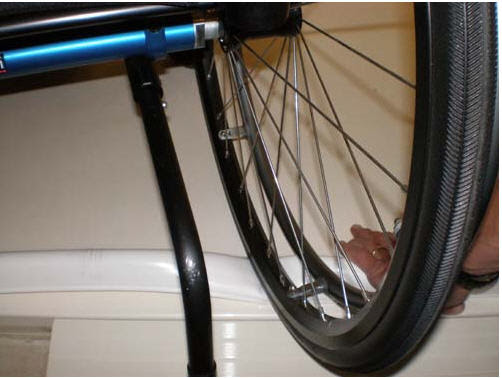
This was a photo of the collapsable curb at the roll in shower.
Based on the advisory of section 304 which discusses turning spaces, this is acceptable:
Advisory Advisory 304.2 Floor or Ground Surface Exception.
As used in this section, the phrase “changes in level” refers to surfaces with slopes and to surfaces with abrupt rise exceeding that permitted in Section 303.3. Such changes in level are prohibited in required clear floor and ground spaces, turning spaces, and in similar spaces where people using wheelchairs and other mobility devices must park their mobility aids such as in wheelchair spaces, or maneuver to use elements such as at doors, fixtures, and telephones.
Monday, March 1st, 2021
ADA Section 213 Toilet Facilities and Bathing Facilities
Section 213.2 of the ADA explains that where toilet room and bathing rooms are provided, each one must comply with the Standards.
There are a few exceptions that allow some toilet rooms and bathing rooms not to have to comply. This newsletter will explain those exceptions and when they can be taken.
ADA Section 213.2 Exceptions
Exception #1 explains that not all restrooms would be required to comply in an alteration when it is technically infeasible to comply and cannot be made compliant due to existing conditions, they do not all have to comply and a the owner must apply for a variance with the AHJ. In such cases, a single user restroom can be used instead.
Exception #2 In a Historic facility (a facility regsitered with the National Register or Landmark Commission) is not required to have all toilet rooms accessible. One unisex restroom will be allowed to be used.
Exception #3 if there are multiple single user portable toilet or bathing rooms that are clustered at a single location, no more than 5% of each must comply.

This is a single user portable toilet room
Exception #4 Where multiple single user toilet rooms are clustered at a single location, no more than 50% of the single user toilet rooms for each use at each cluster shall be required to comply. This section only gives the exception to toilet rooms (even though it is part of the same section that also discusses bathing rooms)
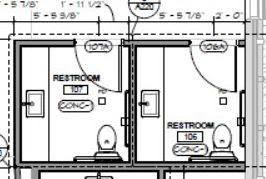
The above image is of two single user restrooms clustered together. Only one must comply
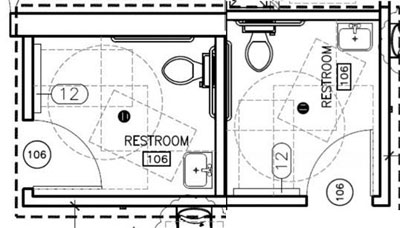
The above image is of two single user restrooms that are not in a cluster because the doors open to separate areas. In the Advisory it explains that a cluster are “within sight of or adjacent to one another”. Both of these toilet rooms must comply

The above image is of multiple single user toilet rooms and multiple single user bathing rooms in a cluseter. In this plan only restroom 117 and 119 can take the exception because they are toilet rooms in a cluster and they are of the same kind.
All the other toilet rooms have showers and therefore are considered bathing rooms. Even though they are in a cluster, there is no exception for bathing rooms that are in a cluster, so all of the bathing rooms must comply.
Section 213.2.1 Unisex or single user restroom or Family restroom and unisex bathing rooms is defined as containing no more than one lavatory,and two water closets without urinals or one water closet, one urinal and one urinal. In addition, a unisex bathing room is considered unisex when it has one shower or one shower/tub, one lavatory and one water closet.
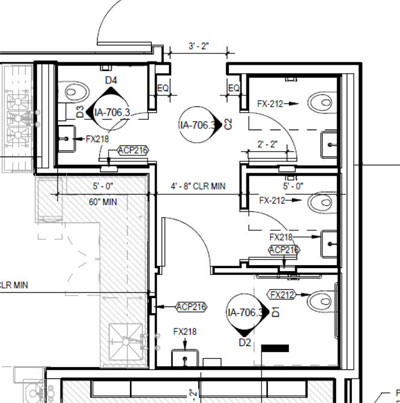
Even though these individual toilet compartments have a lavatory and a water closet, they are located inside a multi-user toilet room and therefore only one compartment is required to comply. These are not single user toilet rooms. These are toilet compartments inside one multi-user toilet room.
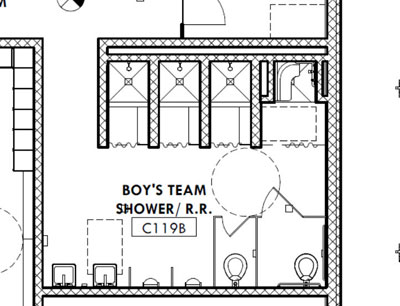
Even though these individual shower compartments, they are located inside a multi-user toilet room and therefore only one compartment is required to comply.


 Abadi
Abadi 










































































































